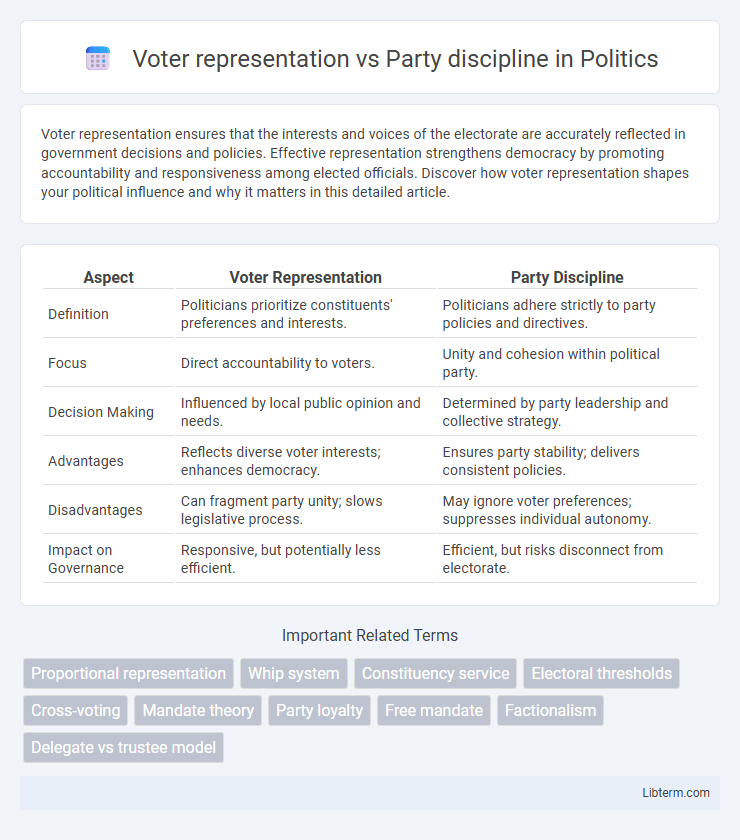Voter representation ensures that the interests and voices of the electorate are accurately reflected in government decisions and policies. Effective representation strengthens democracy by promoting accountability and responsiveness among elected officials. Discover how voter representation shapes your political influence and why it matters in this detailed article.
Table of Comparison
| Aspect | Voter Representation | Party Discipline |
|---|---|---|
| Definition | Politicians prioritize constituents' preferences and interests. | Politicians adhere strictly to party policies and directives. |
| Focus | Direct accountability to voters. | Unity and cohesion within political party. |
| Decision Making | Influenced by local public opinion and needs. | Determined by party leadership and collective strategy. |
| Advantages | Reflects diverse voter interests; enhances democracy. | Ensures party stability; delivers consistent policies. |
| Disadvantages | Can fragment party unity; slows legislative process. | May ignore voter preferences; suppresses individual autonomy. |
| Impact on Governance | Responsive, but potentially less efficient. | Efficient, but risks disconnect from electorate. |
Understanding Voter Representation
Voter representation ensures elected officials reflect the preferences and interests of their constituents, embodying democratic responsiveness within the political system. It involves accurately translating voter preferences into policy decisions, thereby strengthening accountability and trust in governance. Balancing voter representation against party discipline often creates tension, as strict party control can limit an elected representative's ability to advocate for local constituent needs.
The Concept of Party Discipline
Party discipline refers to the mechanisms and practices political parties use to ensure members vote according to the party's official stance rather than personal or constituency preferences. This concept is crucial for maintaining coherent policy agendas and effective governance, as it minimizes dissent and promotes unified decision-making within legislative bodies. Strong party discipline can enhance party stability but may also limit individual representatives' ability to directly reflect their voters' interests.
Historical Evolution of Voter Representation
The historical evolution of voter representation reveals a gradual shift from elite-dominated electoral systems to more inclusive, mass enfranchisement models driven by social movements and democratic reforms. Parliamentary practices evolved to balance direct voter interests with party discipline, emphasizing party cohesion to streamline legislative processes while maintaining constituent accountability. Key milestones include the expansion of suffrage in the 19th and 20th centuries, the rise of political parties, and reforms such as proportional representation that reshaped the relationship between voters, representatives, and party structures.
Origins and Purpose of Party Discipline
Party discipline originated to maintain cohesion and ensure the efficient passage of legislation within political parties, reflecting the need for unified stances in parliamentary systems. It serves the purpose of aligning legislators' votes with party policies, reducing internal dissent and presenting a consistent political front. This mechanism often contrasts with voter representation, as strict party discipline can limit lawmakers' ability to vote according to their constituents' preferences.
Benefits of Strong Voter Representation
Strong voter representation ensures that elected officials directly reflect the interests and concerns of their constituents, enhancing democratic legitimacy and accountability. This alignment promotes policies tailored to local needs and encourages citizen engagement in the political process. Greater voter representation can limit party discipline by empowering representatives to prioritize their voters' preferences over party agendas.
Advantages of Party Discipline in Governance
Party discipline ensures cohesive policy-making by uniting members of a political party behind a common agenda, which streamlines legislative processes and enhances government stability. It reduces the risk of fragmented voting behaviors, allowing governments to pass laws efficiently and maintain consistent policy implementation. Strong party discipline also fosters accountability within the party, as members align their actions with collective goals, promoting unified governance and clear political mandates.
Challenges When Representation Conflicts with Party Discipline
Conflicts between voter representation and party discipline challenge legislators to balance constituent interests with party agendas, often risking political alienation. When party directives clash with voter preferences, representatives face pressure to either conform for political survival or advocate for local demands, complicating legislative effectiveness. This tension undermines democratic accountability and can lead to voter disengagement or intra-party divisions.
Impact on Policy Outcomes and Democracy
Voter representation ensures that elected officials reflect the preferences and interests of their constituents, leading to policies that address diverse local needs and enhance democratic legitimacy. Party discipline promotes policy coherence and stability by encouraging members to support unified platforms, but may suppress individual representatives' responsiveness to their voters. The balance between voter representation and party discipline significantly shapes policy outcomes, with strong party control potentially limiting democratic responsiveness while weak discipline can result in fragmented governance.
Balancing Voter Interests and Party Loyalty
Balancing voter interests and party loyalty requires elected officials to navigate the tension between accurately representing their constituents' preferences and adhering to party platforms. Effective voter representation promotes accountability and responsiveness, while strong party discipline ensures cohesion and consistent policy implementation. Legislators must prioritize transparent communication and strategic decision-making to maintain trust and achieve both constituency satisfaction and party unity.
Future Trends in Representation and Party Discipline
Emerging trends indicate increasing voter demands for authentic representation, pushing parties to balance grassroots responsiveness with cohesive policy agendas. Technological advancements and social media platforms enable direct communication between representatives and constituents, reducing reliance on strict party discipline. As electoral systems evolve, hybrid models may develop that integrate individual accountability with strategic party alignment to enhance democratic legitimacy.
Voter representation Infographic

 libterm.com
libterm.com